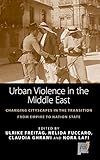Urban Violence in the Middle East : Changing Cityscapes in the Transition from Empire to Nation State / ed. by Ulrike Freitag, Nelida Fuccaro, Claudia Ghrawi, Nora Lafi.
Material type: TextSeries: Space and Place ; 14Publisher: New York ; Oxford : Berghahn Books, [2015]Copyright date: ©2015Description: 1 online resource (334 p.)Content type:
TextSeries: Space and Place ; 14Publisher: New York ; Oxford : Berghahn Books, [2015]Copyright date: ©2015Description: 1 online resource (334 p.)Content type: - 9781782385837
- 9781782385844
- City and town life -- History -- Middle East
- City and town life
- Colonial influence
- Community life -- History -- Middle East
- Community life
- Petroleum industry and trade -- Social aspects -- History -- Middle East
- Petroleum industry and trade -- Social aspects
- Political culture -- History -- Middle East
- Political culture
- Political science
- Social change -- History -- Middle East
- Social change
- Social history
- Sociology, Urban -- History -- Middle East
- Sociology, Urban
- Urban violence -- History -- Middle East
- Urban violence
- Erdölpolitik
- Geschichte
- Gewalt
- Politik
- Verstädterung
- Vertreibung
- Kolonialismus
- Soziale Situation
- Armenier
- Gewalttätigkeit
- SOCIAL SCIENCE / Violence in Society
- 18th century
- big oil
- cairo
- changing cityscape
- city life
- cityscapes
- contemporary politics
- current politics
- diplomacy
- fossil fuel
- historical
- history
- middle eastern history
- middle eastern politics
- nation states
- oil industry
- ottoman empire
- political science
- qajar
- revolutionaries
- sociology
- textbook
- understanding violence
- urban violence
- violence
- war and insurgencies
- wartime
- 303.60956 23/eng
- HN656.Z9
- online - DeGruyter
| Item type | Current library | Call number | URL | Status | Notes | Barcode | |
|---|---|---|---|---|---|---|---|
 eBook
eBook
|
Biblioteca "Angelicum" Pont. Univ. S.Tommaso d'Aquino Nuvola online | online - DeGruyter (Browse shelf(Opens below)) | Online access | Not for loan (Accesso limitato) | Accesso per gli utenti autorizzati / Access for authorized users | (dgr)9781782385844 |
Frontmatter -- Contents -- Figures -- Acknowledgements -- Introduction -- Part I. Managing and Employing Violence -- Chapter 1 Mapping and Scaling Urban Violence: The 1800 Insurrection in Cairo -- Chapter 2 A Capital Challenge: Managing Violence and Disorders in Late Ottoman Istanbul -- Chapter 3 Gendered Obscenity: Women’s Tongues, Men’s Phalluses and the State’s Fist in the Making of Urban Norm in Interwar Egypt -- Part II. Symbolic Politics of Violence -- Chapter 4 Urban Violence, the Muharram Processions and the Transformation of Iranian Urban Society: The Case of Dezful -- Chapter 5 Symbolic Politics and Urban Violence in Late Ottoman Jeddah -- Part III. Communal Violence and its Discontents -- Chapter 6 The 1850 Uprising in Aleppo: Reconsidering the Explanatory Power of Sectarian Argumentations -- Chapter 7 The City as a Stage for a Violent Spectacle: The Massacres of Armenians in Istanbul in 1895–96 -- Chapter 8 Transforming the Holy City: From Communal Clashes to Urban Violence, the Nebi Musa Riots in 1920 -- Part IV. Oil Cities: Spatiality and Violence -- Chapter 9 On Lines and Fences: Labour, Community and Violence in an Oil City -- Chapter 10 Reading Oil as Urban Violence: Kirkuk and Its Oil Conurbation, 1927–58 -- Chapter 11 Structural and Physical Violence in Saudi Arabian Oil Towns, 1953–56 -- Afterword. Urban Injustice, Urban Violence and the Revolution: Reflections on Cairo -- Contributors -- Selected Bibliography -- Index
restricted access online access with authorization star
http://purl.org/coar/access_right/c_16ec
Covering a period from the late eighteenth century to today, this volume explores the phenomenon of urban violence in order to unveil general developments and historical specificities in a variety of Middle Eastern contexts. By situating incidents in particular processes and conflicts, the case studies seek to counter notions of a violent Middle East in order to foster a new understanding of violence beyond that of a meaningless and destructive social and political act. Contributions explore processes sparked by the transition from empires — Ottoman and Qajar, but also European — to the formation of nation states, and the resulting changes in cityscapes throughout the region.
Mode of access: Internet via World Wide Web.
In English.
Description based on online resource; title from PDF title page (publisher's Web site, viewed 25. Jun 2024)


